Problem is, Facebook’s native analytics were shut down in 2021, and Meta Business Suite can only do so much. It gives you some basic metrics, like reach, engagement, and followers. But it lacks depth, customization, and cross-platform visibility. You can’t build a real growth strategy if you’re only looking at surface-level data.
That’s where advanced Facebook analytics tools come in. They help you track performance over time, visualize trends, compare campaigns, and tie your efforts directly to business outcomes like leads or sales.
But with dozens of analytics tools out there, how do you know which one actually helps you track performance, improve content, and hit your goals.
This guide breaks down the best Facebook analytics tools for 2025, so you can choose the right fit whether you’re a marketer, business owner, agency, influencer, or personal brand.
Top 8 Facebook analytics tools at a glance
| Name | Feature Set | Price Range | Best For |
|---|---|---|---|
| Sprout Social | Multi-channel analytics, scheduling, team workflows | $199–$599/seat/month; custom pricing available | Marketing teams and agencies managing multiple channels |
| Buffer | Basic reporting, content scheduling | $12/channel/month; free plan available | Small teams, influencers, freelancers, and personal brands |
| Keyhole | Advanced analytics, social listening, influencer tracking | Custom pricing | Brands with diversified Facebook strategies |
| Meta Business Suite | Native Facebook & Instagram insights, ad management | Free | Beginners or small businesses on a budget |
| Brand24 | Brand mentions, sentiment analysis, share of voice | $199–$599+/month | PR- and reputation-focused brands with blog/news strategies |
| Oktopost | B2B analytics, revenue attribution, CRM integration | Custom pricing | SaaS, legal, finance, and enterprise teams in B2B industries |
| Whatagraph | Cross-channel reporting, SEO/PPC/email integrations | Custom pricing | Agencies and performance-driven marketing teams |
| Superads | Facebook Ads dashboards, AI creative insights, multi-account support | $49–$2,999/month (based on ad spend); free plan available | Ad-focused teams managing Facebook and other platforms |
How we compiled our list
There are hundreds of social media tools out there, but not all of them are built to help you grow a real brand on Facebook.
To create this list, we prioritized tools that are useful for marketers, business owners, and creators with different goals, whether you're tracking ad performance, managing multiple clients, or analyzing brand sentiment.
The goal was to create a diversified list that includes the best tools for different needs.
Our evaluation criteria for Facebook analytics tools
We didn’t just look at shiny features. Each tool was evaluated based on the following:
- Depth of analytics: Does it go beyond reach and likes? Can you track campaigns, conversions, sentiment, or creative performance?
- Unique differentiators: The tools on this list all have capabilities that set them apart from the rest, be that specific integrations or proprietary features for a specific workflow.
- Cross-platform integration: Does it work well with other platforms like Instagram, LinkedIn, or TikTok? What about your website or landing pages?
- Reporting quality: Can it generate clean, customizable reports for clients or internal teams?
- Ease of use: How intuitive is the dashboard? How steep is the learning curve? Enterprise products are inherently more complicated, but we chose platforms that are as straightforward as possible.
- Affordability: Is it reasonably priced for the value it provides? Are there flexible plans for individuals vs. teams?
Use case fit: Is it better for paid ads, PR, influencer campaigns, or overall brand performance?
Not all of these factors matter for each platform in the same way. For example, a micro-influencer with a personal brand won’t need the same extensive feature set or data analysis capabilities as an agency or B2B enterprise (not even close). So, these criteria also help us decide who each product is best for.
Our research and testing process
To build this guide, we:
- Reviewed product documentation, feature lists, and change logs to see how each tool has evolved in 2024 and 2025.
- Analyzed real-world case studies and customer testimonials to evaluate each tool’s practical impact.
- Cross-checked G2, Capterra, and user testimonials to verify strengths and weaknesses.
- Tested each platform (where possible) to see how intuitive the interface is and how easy it is to extract insights.
- Evaluated pricing tiers to understand what value you’re really getting at different levels.
- Got input from our client base and internal Facebook team, who have firsthand experience with these platforms (and dozens of others).
Our list is not sponsored or influenced by any tool providers. We chose platforms based on performance, flexibility, and their ability to deliver actionable Facebook analytics in 2025.
8 best Facebook analytics tools for killer campaign results
Without further ado, let’s jump right into the top Facebook analytics platforms on the market right now.
1. Sprout Social
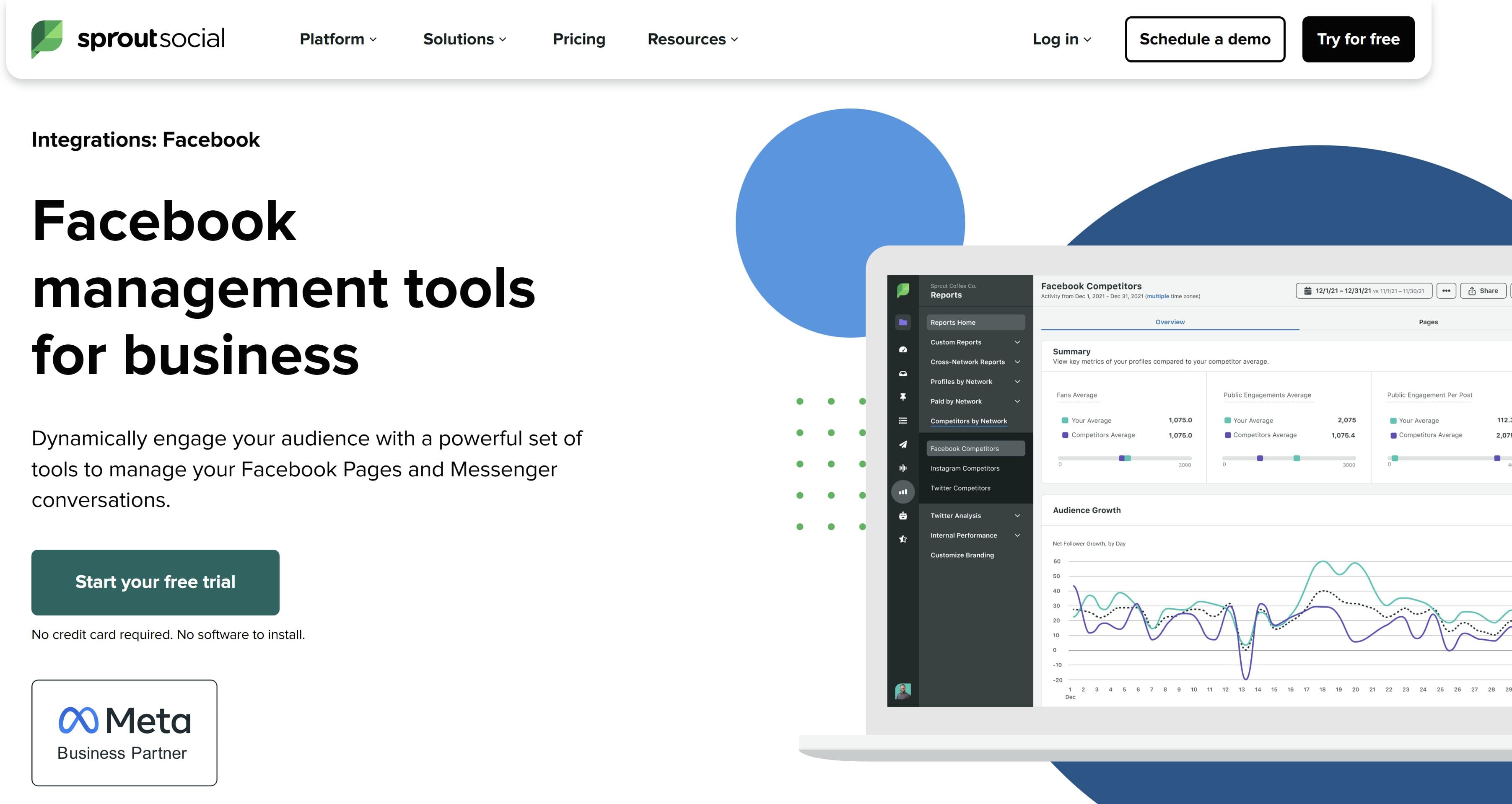
Best for: Marketing teams, agencies, and enterprises managing Facebook alongside other channels.
If you’re managing Facebook as part of a broader multi-channel strategy, Sprout Social gives you the unified control you need. It’s not just a Facebook analytics tool; it’s a full social media command center. It combines robust reporting, smart scheduling, and seamless collaboration, all in one clean interface.
Key features of Sprout Social include:
- Unified analytics for Facebook, Instagram, LinkedIn, X (Twitter), and more
- Customizable and presentation-ready reporting dashboards
- Content calendar with publishing tools and AI-driven optimization
- Social listening for audience sentiment and trends
- Competitor benchmarking and paid vs. organic performance breakdowns
- Team workflows for approvals, task assignments, and internal notes
Grains Research & Development Corporation (GRDC) used Sprout Social to supercharge its Facebook performance. With its tagging, content reports, and internal collaboration tools, GRDC achieved a 101% increase in video views, 79% more impressions, 63% more engagements, and a huge uptick in positive feedback directly from their audience.
| Pros of Sprout Social | Cons of Sprout Social |
|---|---|
| Clean, easy-to-navigate interface | High cost; priced for teams, not individuals |
| Excellent multi-channel visibility | Overkill for solo creators and small brands |
| Custom reports and exportable charts | Analytics lag slightly behind real-time |
| Advanced team collaboration features | Seat-based pricing gets expensive fast |
| Integrated scheduling and reporting | Limited data access on lower-tier plans |
Pricing is broken down into four tiers:
- Standard: $199/seat/month
- Professional: $299/seat/month
- Advanced: $399/seat/month
- Enterprise: Custom pricing based on volume and support needs
2. Buffer
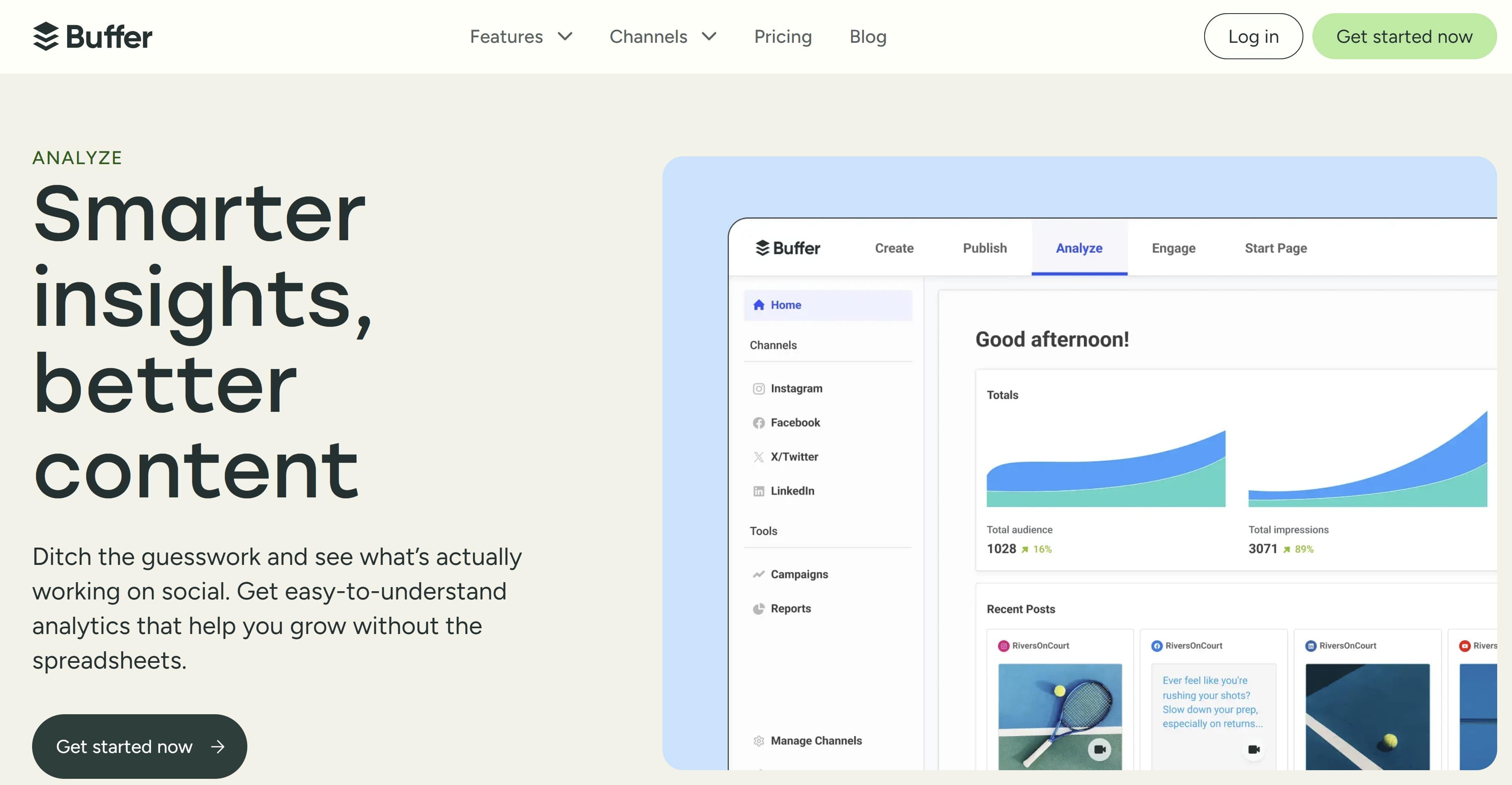
Best for: Influencers, personal brands, small businesses, and lean teams who want clear reporting and easy scheduling.
Buffer is perfect if you want something simple, clear, and affordable. It started out as a scheduling tool but has quietly evolved into a reliable, lightweight analytics platform for Facebook and other major channels.
You won’t get deep-dive data or AI bells and whistles, but you will get clean reports, straightforward insights, and an interface that anyone on your team can figure out in minutes.
Key features of Buffer include:
- Visual post scheduler with drag-and-drop calendar
- Facebook Page analytics for reach, engagement, top posts, and audience trends
- Report sharing with simple exports (great for clients or teams)
- Engagement tracking to see what’s working and when
- Insights into best times to post based on past data
- Integration with Instagram, LinkedIn, X (Twitter), Pinterest, and TikTok
Business Insider is one company that’s had great success using Buffer. With an organized content calendar and insights into what their audience responded to, they grew their Facebook Page from 200,000 to more than 1.3 million fans and more than 5x’ed engagement, all while maintaining a lean, efficient social strategy.
“I’m a reporter/editor/social media guy, so I just need to know right away which post did the best. When I wake up in the morning, I set up all the stuff for overnight. Then I will go back and check on the previous posts and how they did—shares, comments, and clicks are my main indicators. So I can check it out and say, ‘We need to post more like that,’ or ‘We’ll never post that again.’” — Paul Szoldra, West Coast Editor @ Business Insider
The company still uses Buffer and, as of 2025, has a community of 14M on Facebook alone.
| Pros of Buffer | Cons of Buffer |
|---|---|
| Clean, minimal UI; super easy to use | Limited customization in analytics reports |
| Affordable pricing for solopreneurs | No in-depth campaign or paid media analysis |
| Unbeatable for planning and scheduling | Lacks advanced features like listening or benchmarking |
| Great for freelancers, startups, and creators | Grows expensive quickly if managing many channels |
| Includes essentials like reach and engagement | Not ideal for large teams or data-heavy orgs |
Buffer pricing is broken into three tiers:
- Free Plan: 3 channels, basic tools
- Essentials: $6/month per channel
- Team Plan: $12/month per channel
- (Add a Facebook Page? That’s one channel. Add LinkedIn or Instagram? That’s another.)
3. Keyhole
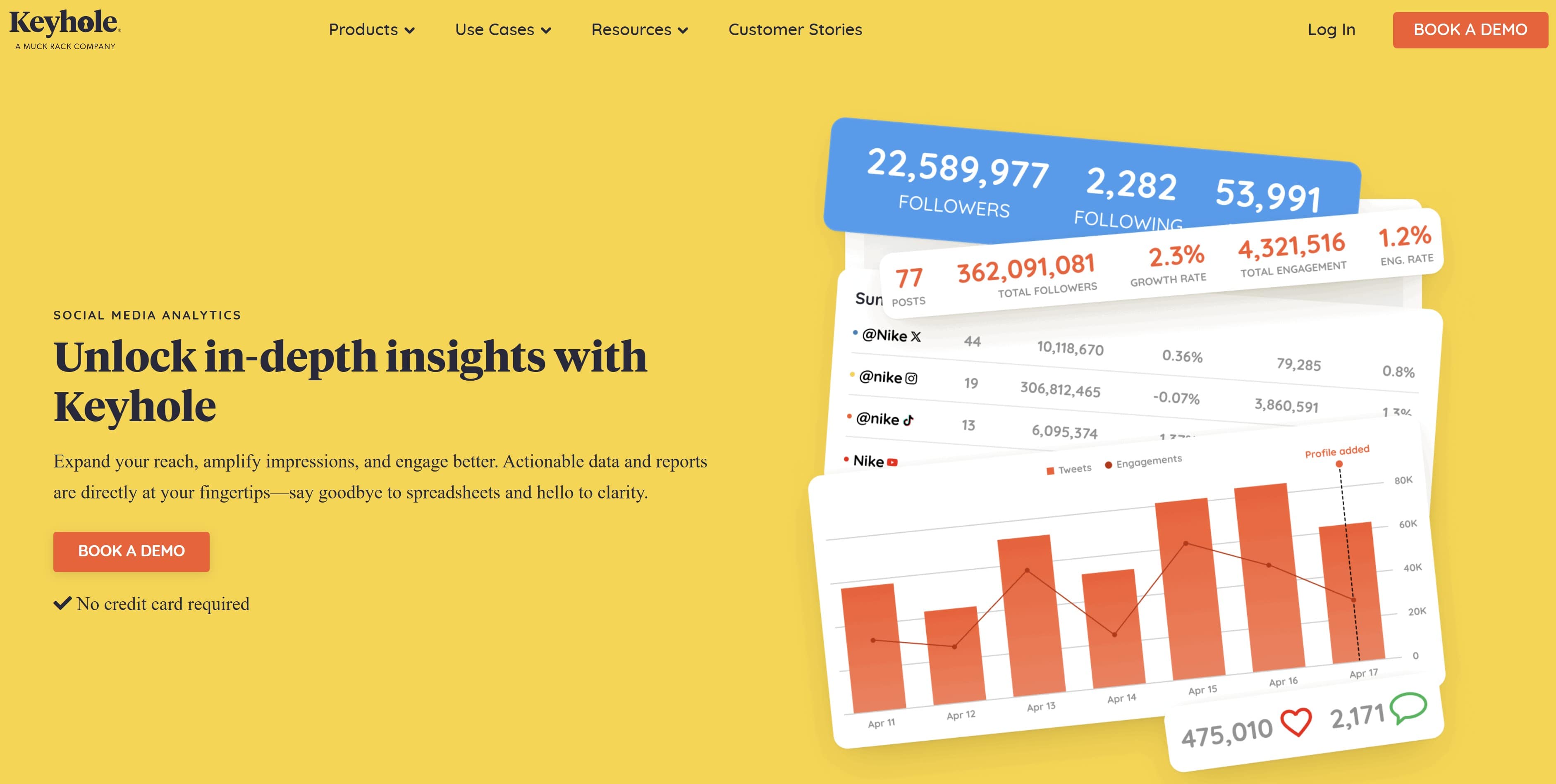
Best for: Global brands running complex and diversified Facebook strategies, particularly with influencers or social listening needs
Keyhole goes beyond basic reporting to give you a full-picture view of your Facebook strategy, from competitor tracking and market research to influencer ROI.
Unlike most tools in this space, Keyhole doesn’t try to be a scheduling platform. It focuses purely on performance insights, market research, and social listening, making it a great choice if you’re running complex campaigns or want to track your Facebook presence from multiple angles.
Key features of Keyhole include:
- Facebook analytics with real-time data on engagement, reach, and growth
- Competitor analysis to benchmark performance and spot content gaps
- Hashtag and keyword tracking across campaigns
- Influencer analytics to evaluate partners and measure campaign ROI
- Social listening to monitor conversations and brand sentiment
- Custom dashboards for multi-channel insights and executive reporting
| Pros of Keyhole | Cons of Keyhole |
|---|---|
| Focused purely on analytics, no fluff | Complex, quote-based pricing |
| Great for multi-dimensional strategies | Steeper learning curve than simpler tools |
| Includes influencer and hashtag tracking | Not ideal for content scheduling or publishing |
| Offers competitor and sentiment analysis | Too complex and expensive for individuals and SMBs |
| Custom dashboards for detailed reporting | Limited supported integrations |
Keyhole uses custom pricing based on your needs. You’ll need to book a demo to get full access and a quote. That said, it’s generally aimed at mid-size to enterprise brands running advanced campaigns, so expect a higher-tier investment.
4. Meta Business Suite
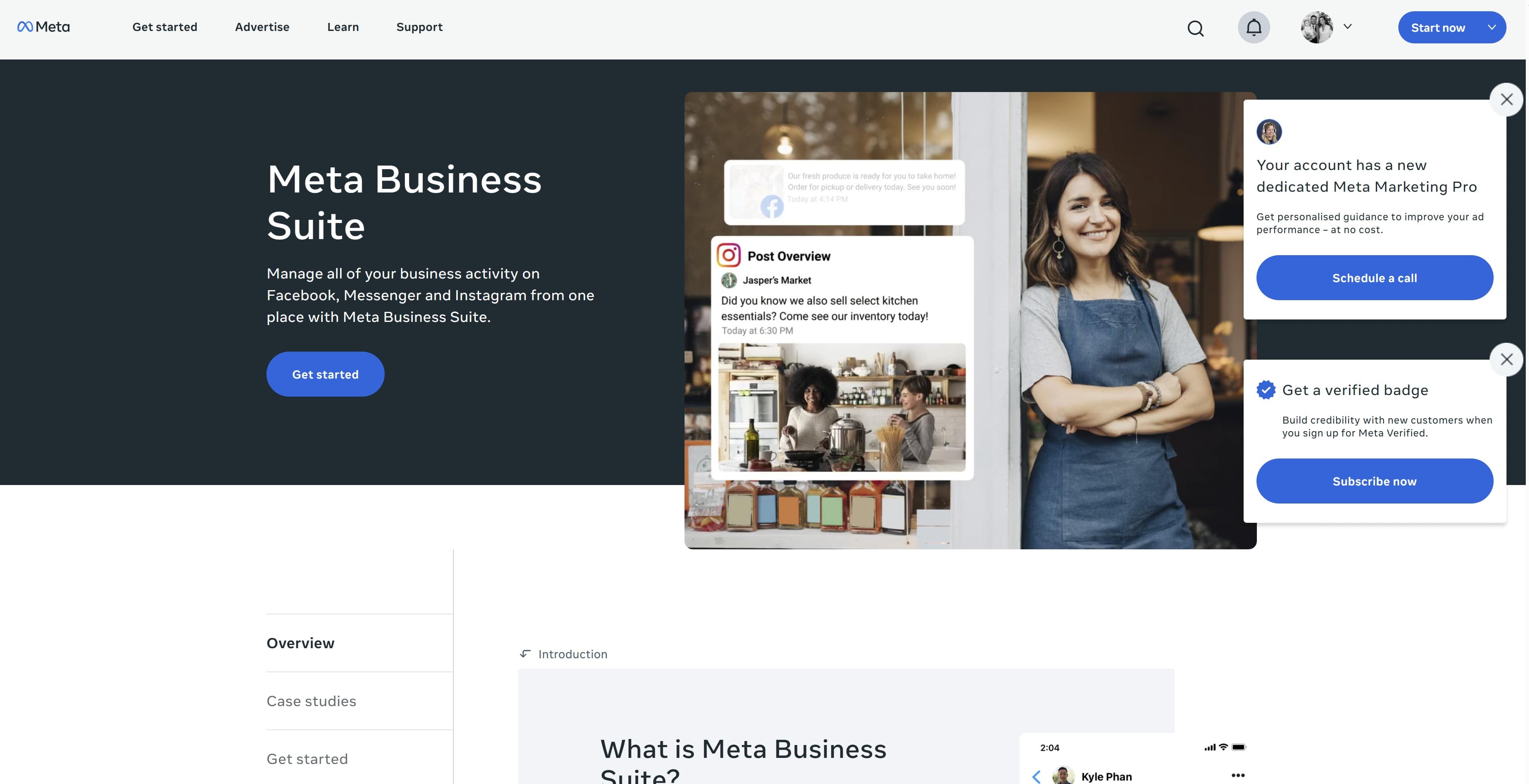
Best for: Beginner users, personal brands, or small businesses that want basic Facebook and Instagram analytics without paying for a third-party tool just yet.
When Facebook shut down the old “Insights” tool, it rolled everything into Business Suite. Now you can view both Facebook and Instagram data in one place, run ads, manage your shop, and schedule posts, all for free.
It’s functional, but barebones. If you're just starting out or don’t want to invest in a paid platform, it's a fine place to begin. Just know its limitations.
Features of Meta Business Suite include:
- Free access to insights for Facebook and Instagram
- See metrics like reach, engagement, Page growth, and post performance
- Cross-post content across Meta platforms
- Manage ads and boosted posts from the same interface
- View commerce, ad spend, and messaging all in one dashboard
- Schedule posts and stories directly in the platform
| Pros | Cons |
|---|---|
| 100% free to use | Limited depth and customization in reporting |
| Native to Facebook/Instagram; no setup needed | Analytics UI can be buggy or slow |
| Basic publishing, messaging, and ad tools | Documentation is inconsistent and often outdated |
| Simple insights for top posts and engagement | No competitor analysis or sentiment tracking |
| Works fine for basic metrics and small teams | Poor support and no ability to export custom reports |
Meta Business Suite is free to use. No upgrades, no tiers. All you have to do is sign in with your Facebook profile and you’ll have access to the whole platform.
5. Brand24
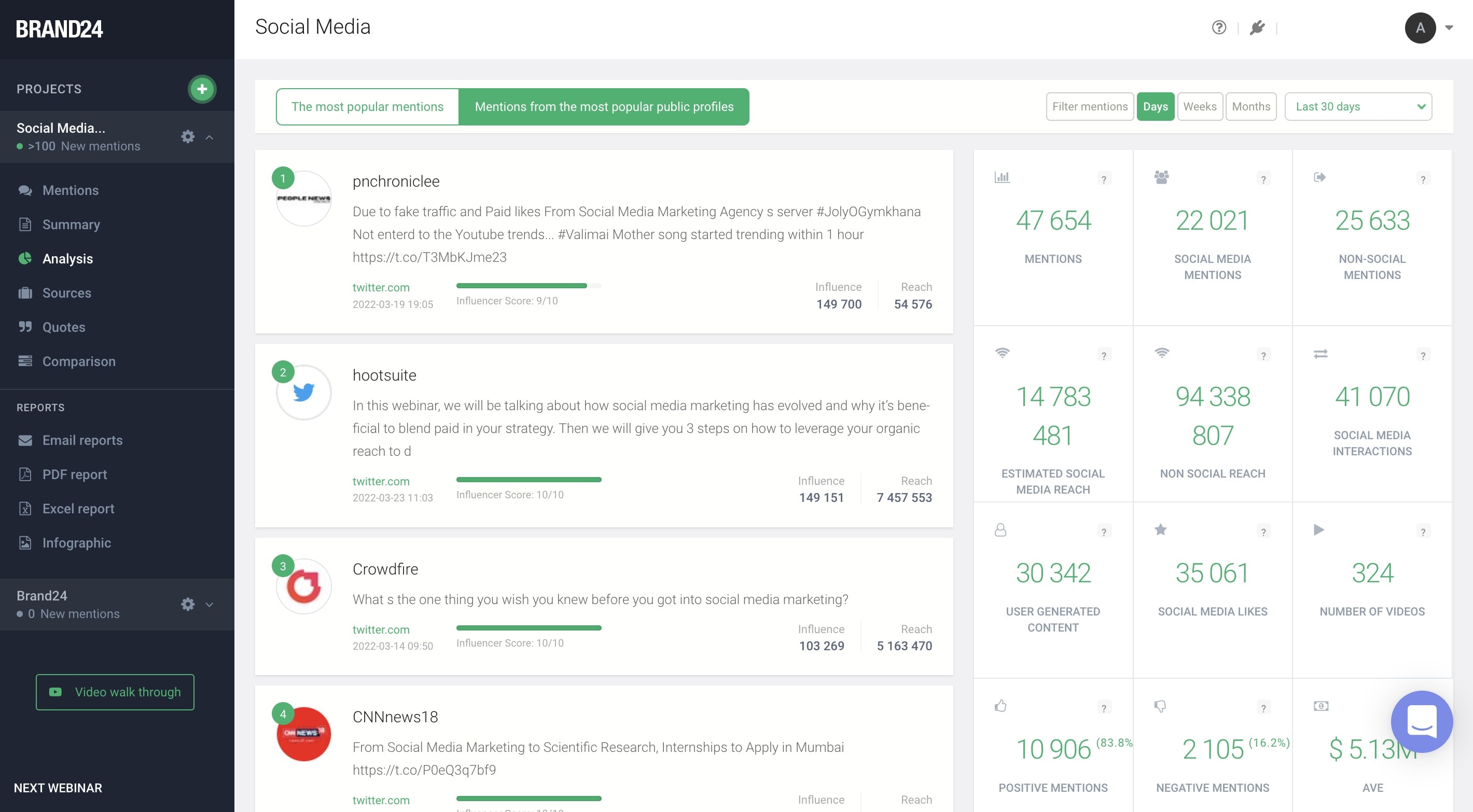
Best for: PR teams, agencies, and multichannel brands that need to track multiple socials, blogs, and news outlets in addition to Facebook analytics
Brand24 is more than a Facebook analytics tool; it’s a social listening powerhouse. If you’re running PR campaigns, reputation management, or multichannel brand awareness strategies, Brand24 helps you go way beyond post likes and impressions. It tracks untagged mentions, analyzes public sentiment, and gives you a holistic view of your brand's online footprint.
Its proprietary Reputation Score and Presence Score offer unique benchmarks you won’t get from other tools (brand health and awareness, respectively). And its unlimited-user model makes it surprisingly cost-effective for teams.
Features of Brand24 include:
- Real-time monitoring of brand mentions (tagged and untagged) on Facebook and other platforms
- AI-powered sentiment analysis (positive, neutral, negative)
- Share of voice, reach metrics, and competitive benchmarking
- Reputation Score and Presence Score to track brand health and awareness
- Alerts for spikes in mentions or negative sentiment
- AI-generated, presentation-ready reports
- Insights into which platforms drive the most buzz for your brand
| Pros of Brand24 | Cons of Brand24 |
|---|---|
| Advanced sentiment analysis with brand scores | Not designed for scheduling or publishing content |
| Tracks untagged mentions (rare among analytics tools) | Is pricey if you don’t need centralized social media, blog, and news analytics |
| Strong data security and protection measures | Steeper learning curve if you only need basic metrics |
| Great for PR, crisis monitoring, and brand health | Reporting focused more on brand perception than posts |
| Covers multiple platforms in one dashboard | More useful for strategic analysis than tactical content planning |
Brand24 pricing is split up into five separate tiers:
- Individual: $199/month (1 brand)
- Team: $299/month
- Pro: $399/month
- Business: $599/month
- Enterprise: $600+/month (custom)
All plans include unlimited users, so even large teams won’t need extra seats
6. Oktopost
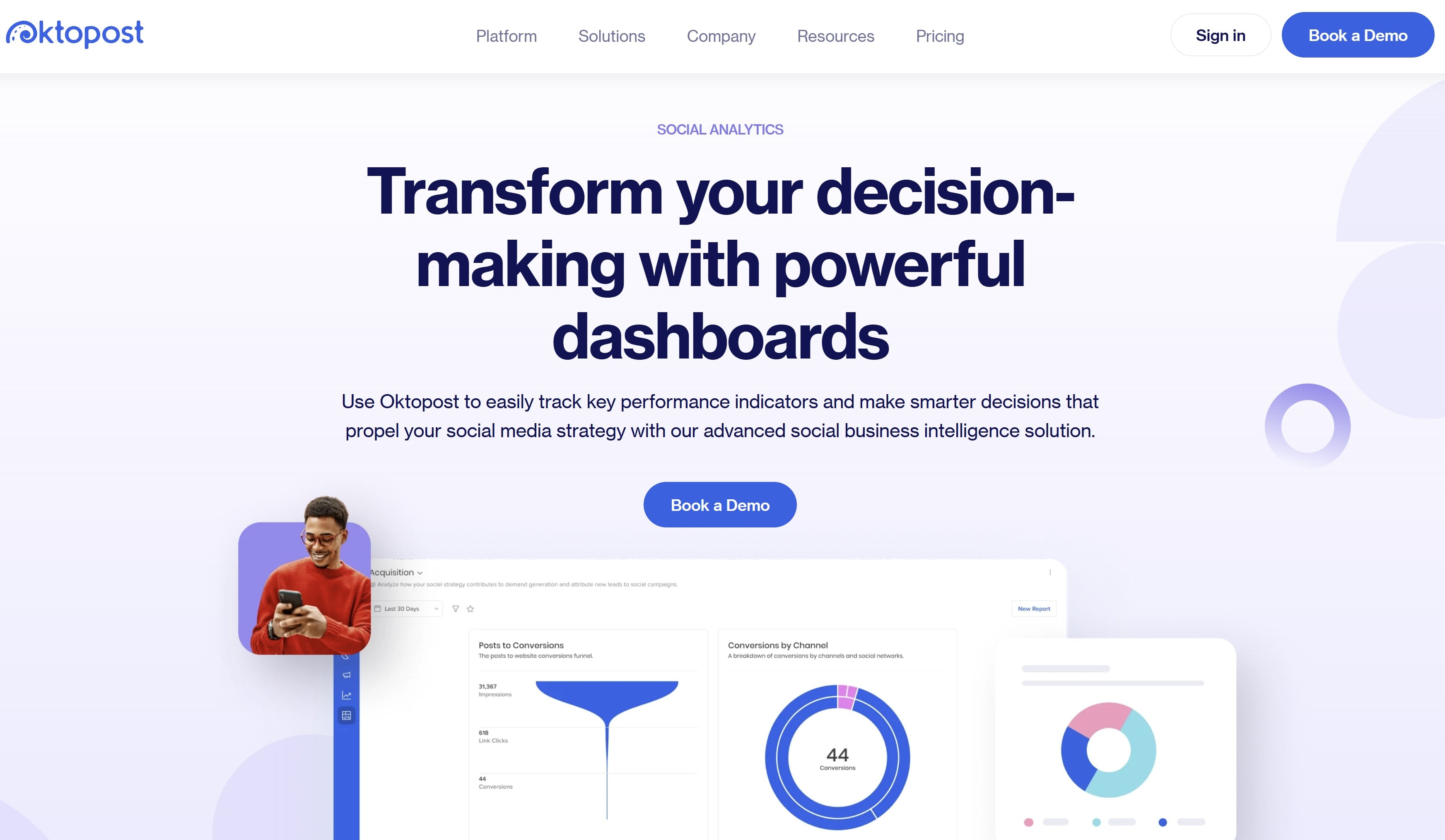
Best for: B2B companies in SaaS, FinTech, legal, or professional services who need end-to-end social media analytics, revenue attribution, and social selling tools.
Most social analytics tools are built for B2C brands. Oktopost is different; it’s purpose-built for B2B companies with longer sales cycles, niche audiences, and a need to prove ROI.
It doesn’t just track engagement on Facebook, it maps how social interactions contribute to leads, pipeline, and revenue. From social selling features to employee advocacy tools and CRM integrations, Oktopost is a true enterprise-grade platform for marketers who need more than vanity metrics.
Key features of Oktopost include:
- Multi-channel analytics with B2B buyer journey tracking
- Revenue attribution for organic and paid Facebook content
- CRM and marketing automation integrations (HubSpot, Salesforce, Marketo, etc.)
- Social listening across platforms for sentiment and industry insights
- Employee advocacy tools to amplify posts via your team
- Social inbox and customer support features for helpdesk teams
- Analytics for social selling and lead generation impact
One company that uses the platform successfully is London-based IFS. They used analytics to curate industry-specific content, had employees across various departments and regions to share relevant posts, and positioned themselves as thought leaders as a result.
Since implementation, they’ve seen a 394% increase in engagement, 135% follower growth, 107% increase in brand mentions (113,000 total mentions)
| Pros of Oktopost | Cons of Oktopost |
|---|---|
| Built specifically for B2B marketing and revenue impact | No fake follower detection or creator vetting tools |
| Maps social data to leads, pipeline, and sales | Takes time to learn enterprise-level UX |
| Strong integrations with B2B tools like CRMs | Pricing is custom and higher than SMB tools |
| Includes social selling and employee advocacy | Might be overkill for smaller or B2C-oriented brands |
| Combines analytics with social inbox and support tools | No public pricing, no freemium or entry-level option |
Oktopost pricing is fully custom. It’s based on company size, features needed, and level of support. There’s also no free plan or entry-level option; it’s built for serious B2B teams.
7. Whatagraph
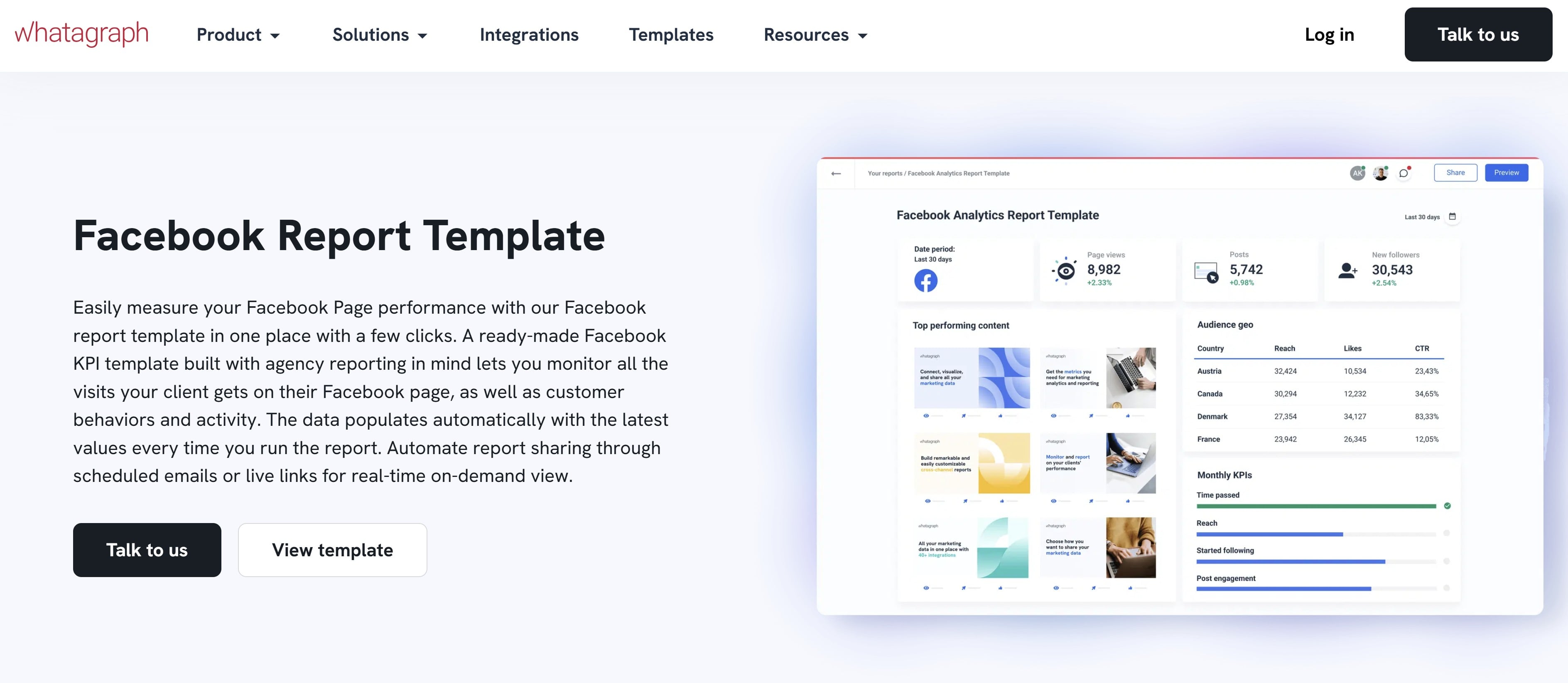
Best for: Growing agencies and performance marketing teams that need a tool to simplify their data-heavy processes.
If your team juggles multiple channels, ad accounts, and clients, Whatagraph brings order to the chaos. It’s a centralized analytics platform that makes Facebook performance data easy to interpret, while also pulling in SEO, email, PPC, and web analytics metrics into one beautifully visualized dashboard.
Whatagraph replaces messy spreadsheets and clunky exports with automated reports that actually make sense to clients and stakeholders. And it’s got tons of pre-built templates, including one of our favorites for Facebook analytics reporting.
Key features of Whatagraph include:
- Facebook Page and Facebook Ads reporting in real time
- Cross-channel performance dashboards (SEO, PPC, email, web analytics)
- 40+ native integrations (GA4, HubSpot, Mailchimp, Google Ads, and more)
- Custom report builder with widgets, charts, and branding options
- Automated client reports delivered on a schedule
- Data warehousing integration (BigQuery)
- Easy sharing with link-based or PDF exports
Rekom Group, a leading nightlife operator in Northern Europe, is one company that saw huge results with the platform. They effectively used Whatagraph's analytics platform to manage and optimize their Facebook marketing efforts across over 200 venues in four countries.
With the platform, they were able to either look at everything from a global perspective, or break it down into countries. They could even see specific KPIs for a single bar or nightclub.
| Pros of Whatagraph | Cons of Whatagraph |
|---|---|
| Great for multi-channel reporting and cross-platform view | No free plan or trial without booking a demo |
| Perfect for agencies managing multiple clients | Only supports BigQuery as a data warehouse (for now) |
| Custom visualizations with strong branding options | Not built for social publishing or engagement tasks |
| Automates reporting and saves tons of manual work | Can be pricey for solo marketers or very small teams |
| Supports SEO/PPC/email + social in one dashboard | Data syncs can take time depending on integration load |
Pricing for Whatagraph is fully custom. It’s personalized to you based on the number of team members and client workspaces needed, as well as the data sources, integrations, and reporting frequency it needs to support.
8. Superads
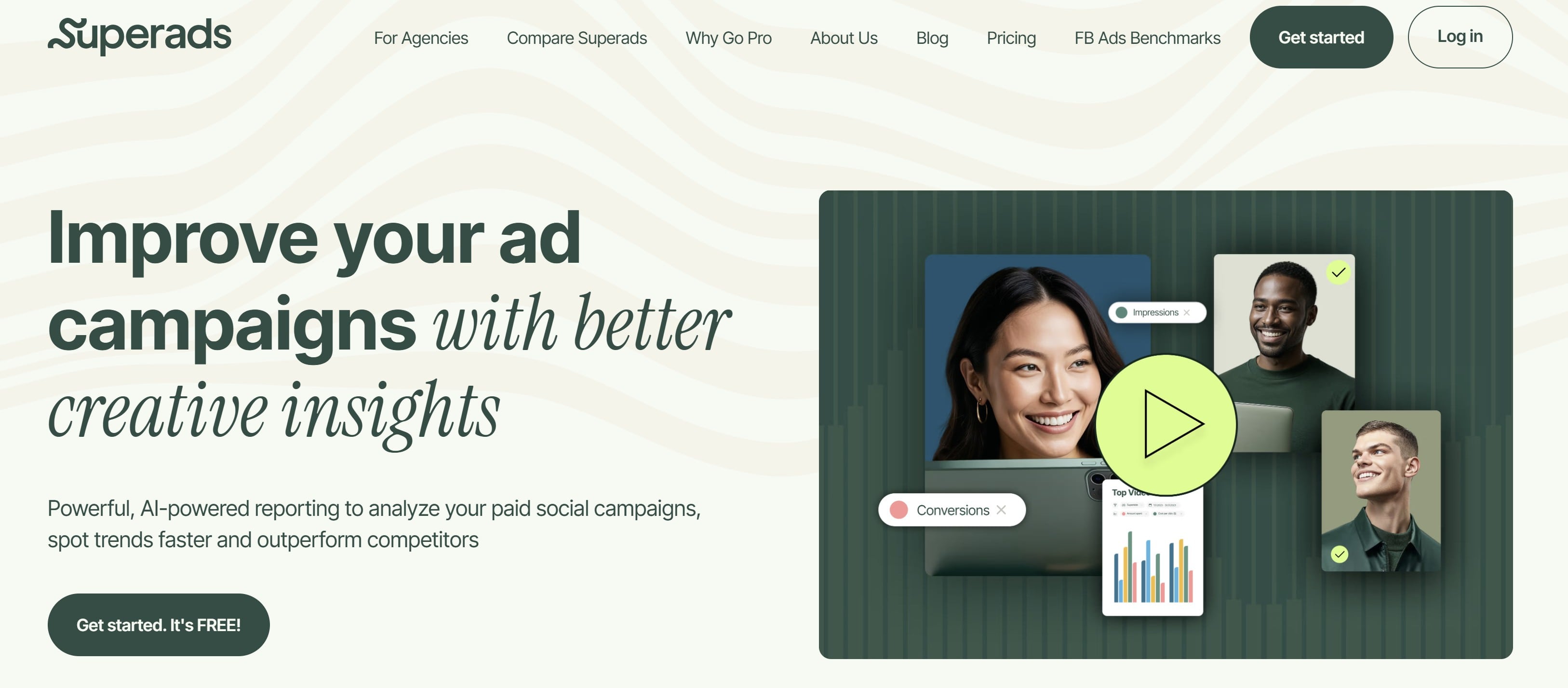
Best for: Companies of all sizes running Facebook ads.
Superads is a performance-focused analytics tool made for paid media teams, not content creators or social schedulers. What makes it stand out is how fast it turns Facebook Ads data into team-ready dashboards, campaign breakdowns, and even AI insights on which creative is actually driving results.
You can connect unlimited Meta ad accounts (even on the free plan), track detailed breakdowns, and compare performance across platforms like LinkedIn and TikTok from a single interface.
Key features of Superads include:
- Customizable dashboards to track key KPIs like CTR, ROAS, and spend
- AI-powered analysis of creative tone, themes, and CTA effectiveness
- Real-time collaboration tools for creative, strategy, and ad teams
- Unlimited Meta ad accounts connected, even on free tier
- Multi-platform ad reporting (Meta, TikTok, LinkedIn)
- 15+ breakdown dimensions for Meta performance
- Automated, presentation-ready reports
| Pros of Superads | Cons of Superads |
|---|---|
| Built for paid ad teams, not generic social analytics | Only valuable if you’re actively running ad campaigns |
| Unlimited ad accounts, even on free plan | AI features still in beta |
| Combines creative, performance, and strategy views | Not for content posting or organic engagement |
| Strong creative insights on what’s driving results | Smaller feature set outside of ad performance |
| Multi-account, multi-platform support is seamless | No influencer tracking, social listening, etc. |
Superads pricing is broken into one free and one paid tier:
- Free forever: Unlimited ad accounts
- Paid: Start at $49/month, scale based on monthly ad spend (up to $2,999/month for $3.5M/month on ads)
How to choose the right Facebook analytics tool for your business
As you’ve probably figured out from reading each tool’s description, you don’t just pick the one with the most features. Many platforms are quite different from each other. It’s about finding the right fit for your business model, your marketing workflow, and your actual goals.
1. Start with your primary goal.
What are you actually trying to improve here?
- Running ad campaigns? You’ll need detailed CTR, CPC, and conversion tracking. Prioritize tools like Superads or Sprout Social with granular paid media insights.
- Building brand awareness? Focus on sentiment analysis, share of voice, and untagged mentions. Tools like Brand24 or Keyhole are designed for this.
- Managing multiple clients or platforms? Cross-channel dashboards, white-label reporting, and automation are your priorities. Whatagraph or Sprout Social are ideal.
- Tracking ROI in B2B? Look for tools with CRM integrations and revenue attribution. Oktopost is built for this exact use case.
And if you’re just getting started as a creator or personal brand, a free or low-cost tool like Buffer has the perfect feature set for you, without any of the extras that’ll complicate things.
2. Match the tool to your team size and workflow.
Solo creators and small business owners: You’ll want something fast, simple, and affordable. Avoid big, confusing dashboards you’ll never fully use.
For brand marketing teams and small to mid-sized agencies, collaboration features like approval workflows, shared dashboards, or team-based permissions are incredibly important. And for agencies especially, reporting automation is key. Pick tools that let you duplicate templates, customize branding, and export easily for multiple clients.
For cross-functional teams, sure the tool integrates with your project management and CRM stack (e.g., HubSpot, Salesforce, Notion, Slack). That way, everyone involved will always be aligned.
3. Assess data depth and reporting flexibility.
Basic metrics like reach, likes, and followers are fine for a glance, but serious decision-making requires:
- Campaign-level insights
- Custom date ranges and segment filters
- Exportable, branded reports
- Breakdowns by creative, demographic, placement, device, etc.
Not every business needs 40 layers of granularity. But you should at least make sure the tool gives your team the ability to measure what matters to you.
4. Look at integration and channel coverage.
Even if Facebook is your main focus now, you might expand into:
- Instagram (same ecosystem)
- TikTok (great for Reels crossover)
- LinkedIn (especially for B2B)
- Email, SEO, or web traffic (to tie awareness to results)
Choose a platform that can grow with you. If you're already using GA4, HubSpot, or Mailchimp, it makes sense to pick a tool that integrates with those platforms out of the box, like Whatagraph or Oktopost.
5. Evaluate price vs. value, not just cost.
Don’t just go for the cheapest tool. Go for the one that pays for itself. If a tool saves you hours per week in manual tracking or reporting, helps you spot underperforming creatives before your ad budget gets wasted, and wins your clients or justifies spend to stakeholders with clean reports, chances are it’s worth the money.
6. Don’t forget about support, documentation, and usability.
Some tools look great on paper but have poor support or outdated documentation. Others are too complex for most teams to adopt. The best analytics tool is one your team actually uses consistently.
Before committing, request a demo and ask the hard questions around product limitations at your price tier (e.g., data sampling or historical depth), how fast the data is updated, and what resources there are available to drive adoption (like documentation).
Also, have a few of your core users test the UI and give you feedback on how intuitive it is. They should be involved from the very beginning. And check if the company has an active support team or just a chatbot.
The bottom line
There is no “best” Facebook analytics tool, only the best one for you. Make your decision based on:
- Your goals
- Your team’s workflow
- Your existing tool stack
- The time/value tradeoff
- And the level of insight you truly need
Take your time. Get the demo. Run a trial. Your Facebook data is only valuable if you can turn it into action, and that starts with choosing the right tool.

